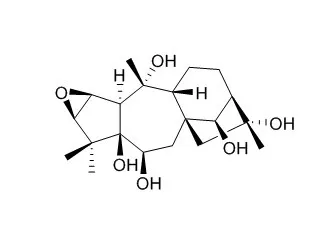| In vitro: |
| Arch Insect Biochem Physiol. 2014 Jun;86(2):122-36. | | Contacting is essential for oviposition deterrence of Rhodojaponin-III in Spodoptera litura.[Pubmed: 24782249] | In Lepidoptera, choosing the right site for egg laying is particularly important, because the small larvae cannot forage for alternate host plants easily. Some secondary compounds of plants have the ability to deter oviposition behaviors of insects.
METHODS AND RESULTS:
Rhodojaponin III, a botanical compound, has been reported to have intense deterring-oviposition activity against many insects, which have important implications for agricultural pest management. This study provided evidence for elucidating the perception mechanism underlying Rhodojaponin III as oviposition deterrent. In this study, the antennas of moths could not elicit notable electroantennogram responses to Rhodojaponin III, which suggested the Rhodojaponin III could not exert effects like those volatile compounds. The results of physiological experiments confirmed the Rhodojaponin III could produce the oviposition deterrence effect against moths without depending on antennas, while the physical contact was essential for perceiving the compound, which suggested that the sensilla on tarsus and ovipositor could be chemoreceptor for Rhodojaponin III. Therefore, these sensilla were investigated by scanning electron microscopy to explore their potential functions in detecting Rhodojaponin III.
CONCLUSIONS:
This study highlighted the contacting mechanism in deterring oviposition behaviors of moths by Rhodojaponin III and provided new insight for development of contact-based pest management. | | PLoS One. 2013 Jul 5;8(7):e67723. | | Proteomic and properties analysis of botanical insecticide rhodojaponin III-induced response of the diamondback moth, Plutella xyllostella (L.).[Pubmed: 23861792] | Rhodojaponin III, as a botanical insecticide, affects a wide variety of biological processes in insects, including reduction of feeding, suspension of development, and oviposition deterring of adults in a dose-dependent manner. However, the mode of these actions remains obscure.
METHODS AND RESULTS:
In this study, a comparative proteomic approach was adopted to examine the effect of Rhodojaponin III on the Plutella xyllostella (L.). Following treating 48 hours, newly emergence moths were collected and protein samples were prepared. The proteins were separated by 2-DE, and total 31 proteins were significantly affected by Rhodojaponin III compared to the control identified by MALDI-TOF/TOF-MS/MS. These differentially expressed proteins act in the nervous transduction, odorant degradation and metabolic change pathways. Further, gene expression patterns in treated and untreated moths were confirmed by qRT-PCR and western blot analysis. RNAi of the chemosensory protein (PxCSP) gene resulted in oviposition significantly increased on cabbage plants treated with Rhodojaponin III.
CONCLUSIONS:
These Rhodojaponin III-induced proteins and gene properties analysis would be essential for a better understanding of the potential molecular mechanism of the response to Rhodojaponin III from moths of P. xylostella. |
|






 Cell. 2018 Jan 11;172(1-2):249-261.e12. doi: 10.1016/j.cell.2017.12.019.IF=36.216(2019)
Cell. 2018 Jan 11;172(1-2):249-261.e12. doi: 10.1016/j.cell.2017.12.019.IF=36.216(2019) Cell Metab. 2020 Mar 3;31(3):534-548.e5. doi: 10.1016/j.cmet.2020.01.002.IF=22.415(2019)
Cell Metab. 2020 Mar 3;31(3):534-548.e5. doi: 10.1016/j.cmet.2020.01.002.IF=22.415(2019) Mol Cell. 2017 Nov 16;68(4):673-685.e6. doi: 10.1016/j.molcel.2017.10.022.IF=14.548(2019)
Mol Cell. 2017 Nov 16;68(4):673-685.e6. doi: 10.1016/j.molcel.2017.10.022.IF=14.548(2019)